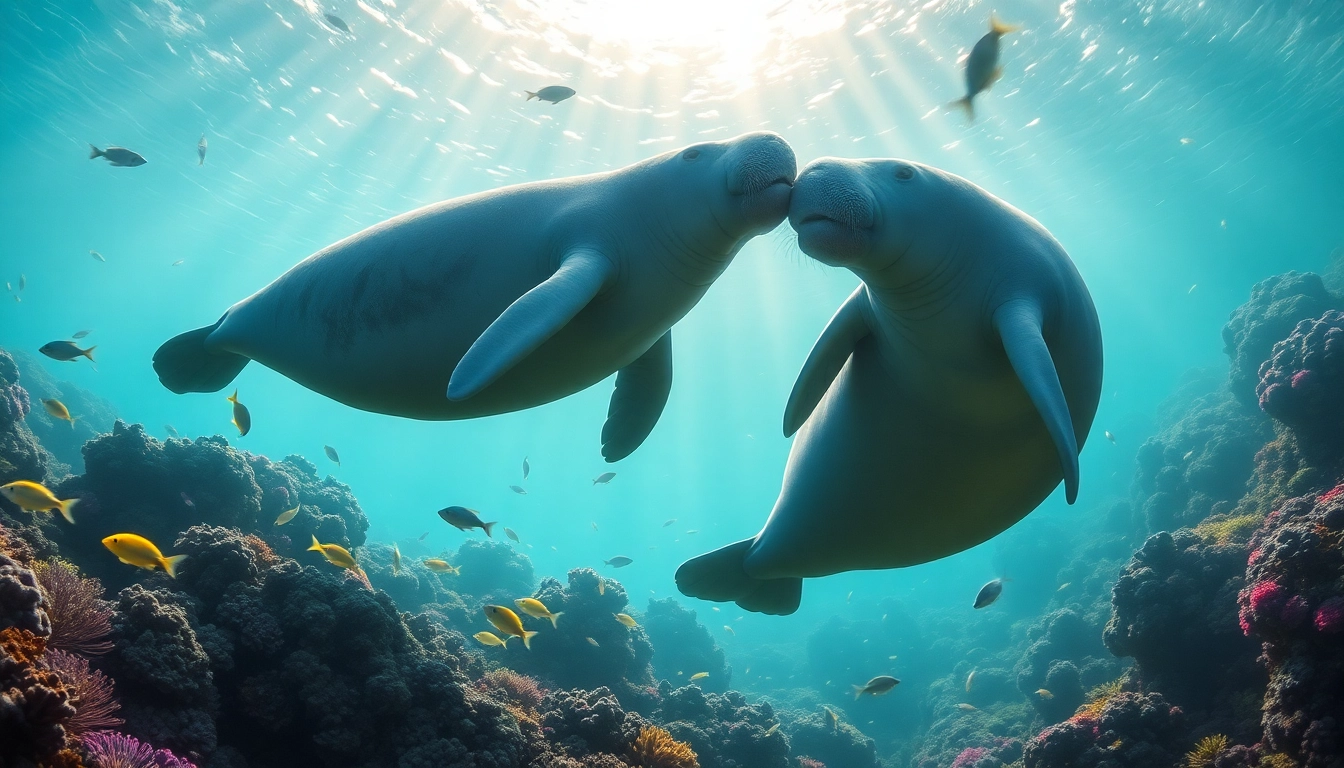Understanding Manatees Puerto Rico
Manatees, gentle giants of the sea, evoke fascination and admiration, especially in regions where they are commonly found. In manatees puerto rico, these marine mammals serve as a remarkable symbol of the island’s diverse ecosystem. Understanding the biology, behavior, and distribution of manatees within this stunning locale is vital for both conservation efforts and ultimately, ensuring that future generations can appreciate their beauty.
What Are Manatees?
Manatees, also known as sea cows, belong to the order Sirenia. These aquatic mammals are herbivorous and can grow up to 13 feet in length, weighing as much as 1,300 pounds. Manatees possess a unique, streamlined body that aids in gliding through water. Their paddle-like flippers assist in steering while grazing on aquatic vegetation, which forms a significant part of their diet.
There are three species of manatees: the West Indian manatee, the Amazonian manatee, and the African manatee. Puerto Rico is predominantly home to the West Indian manatee, which is further divided into the Florida manatee and the Antillean manatee. The latter inhabits the Caribbean region, including Puerto Rico.
Habitat and Distribution in Puerto Rico
Manatees are generally found in warm, shallow coastal waters where there is an abundance of seagrass. In Puerto Rico, popular habitats include estuaries, coastal lagoons, and bays. A significant concentration of manatees can be spotted in the southern coastal areas, including places like La Parguera and the shores of Lajas, as well as the northern region, especially in the bays around Fajardo. Their preference for warm waters informs their migratory habits, with manatees seeking refuge in these environments during the colder months.
Oil spills, urban development, and water pollution have threatened these habitats. Thus, understanding where manatees live helps shape conservation initiatives aimed at protecting their natural environments.
Life Cycle and Behavior of Manatees
Manatees have a slow reproduction rate; females typically give birth to a single calf every two to five years after a gestation period of approximately 12 months. Calves weigh around 60 to 70 pounds at birth and are dependent on their mothers for up to two years. This lengthy dependency emphasizes the importance of protecting mother-calf pairs, particularly amidst environmental stressors that drain resources and habitat availability.
Behaviorally, manatees are social creatures, often found in small groups. They communicate using a series of squeaks, whistles, and chirps, which range in complexity and tone. Manatees are known to be curious, sometimes interacting with swimmers and boats, but they rely heavily on their spatial memory to navigate their environments.
Where to Find Manatees Puerto Rico
Top Locations for Manatee Sightings
User-friendly sites for manatee watching include:
- Condado Lagoon: Situated near San Juan, this coastal lagoon is a hotspot for manatee sightings. Visitors often report seeing manatees reaching for air simply by paddleboarding or kayaking.
- La Parguera: This region on the southwest coast is renowned for its rich biodiversity, including manatees. The area’s seagrass beds provide an ideal grazing spot.
- Bay of Fajardo: Well-known for its beauty, the bay also serves as a popular habitat for manatees, frequently sighted near the shorelines.
- Flamenco Beach, Culebra: A bit further out, Culebra offers secluded areas where manatees are known to thrive, particularly in marine protected areas.
Best Times of Year for Viewing
The best time to observe manatees in Puerto Rico is generally during the warm months from late spring to early fall. This is because manatees tend to migrate and appear more frequently in coastal regions to feed. Early mornings and late afternoons present optimal conditions for sightings, with lower water activity enhancing visibility. Visitors should also check local weather conditions before planning their excursions, as cooler temperatures can drive manatees to warmer waters.
Guided Tours and Experiences
To enhance the experience of viewing manatees, several local environmental organizations and eco-tour operators offer guided tours focusing on manatee habitat exploration. These tours not only provide excellent opportunities for sightings but also associated educational components about the species and their habitats. Tour operators often come equipped with knowledgeable guides who share insights into the behavior, habitat, and conservation efforts surrounding manatees.
Additionally, participants are encouraged to maintain responsible viewing practices, such as keeping a safe distance from the animals and avoiding any actions that may disturb their natural behaviors. Always ensure to choose an operator committed to ethical wildlife practices.
Conservation Efforts for Manatees Puerto Rico
Challenges Faced by Manatees
Despite the ecological importance of manatees in their respective habitats, they face numerous challenges that threaten their existence. The most significant of these challenges include:
- Habitat Loss: Urban development, particularly along coastlines, has led to the destruction of seagrass beds and wetlands, critical habitats for manatees.
- Boating Traffic: Collisions with boats account for a high percentage of manatee injuries and fatalities. Because they often surface in shallow waters where boaters are active, manatees are especially vulnerable.
- Water Quality: Polluted waters with chemical runoff can harm manatees, leading to diseases affecting their health and reproductive success. Harmful algal blooms can deplete oxygen levels, further stressing the animals.
- Climate Change: Changes in water temperature and coastal erosion as a result of climate change threaten manatee habitats, exacerbating risks associated with habitat loss and availability of food sources.
Initiatives for Manatee Protection
Several government and non-profit organizations in Puerto Rico are actively engaged in protecting manatees and their habitats. Initiatives range from education campaigns about responsible boating practices to habitat conservation projects aimed at restoring seagrass beds. Some key initiatives include:
- Caribbean Manatee Conservation Center: This organization focuses on rescue, rehabilitation, and research activities aimed at understanding manatee biology and habitat needs.
- Public Educational Programs: These programs aim to educate local communities and visitors about the importance of manatees in the ecosystem and promote awareness of conservation challenges.
- Regulatory Measures: Governmental policies aimed at establishing speed zones in waters frequented by manatees help minimize the risk of boat collisions and subsequent injuries.
How You Can Help
Conservation of manatees in Puerto Rico requires concerted efforts from locals and visitors alike. Here are several actions you can take to contribute:
- Participate in Clean-Up Efforts: Join local groups that organize beach and waterway cleanups to help reduce pollution in manatee habitats.
- Spread Awareness: Educate others about the importance of manatees and the threats they face, encouraging responsible behavior while visiting natural areas.
- Support Conservation Organizations: Donate to or volunteer with organizations focusing on marine conservation and manatee rehabilitation.
- Follow Boating Regulations: Adhere to speed limits and no-wake zones in areas known to be frequented by manatees.
Swimming and Kayaking with Manatees Puerto Rico
Best Practices for Responsible Interactions
Engaging with manatees while swimming or kayaking can be a magical experience. However, it is paramount to ensure such interactions are conducted responsibly to prevent negative impacts on these animals. Best practices include:
- Keep a Distance: Observers should maintain a distance of at least 10 feet from manatees to avoid causing stress, which can be detrimental to their health.
- Do Not Touch or Feed: Interactions such as feeding or touching can lead to behavioral changes in manatees, harming their natural instincts and making them more vulnerable.
- Avoid Pursuing: If you spot a manatee, resist the urge to pursue them. Instead, allow them to come closer naturally if they choose.
Safety Guidelines for Water Activities
When undertaking water activities such as swimming or kayaking in manatee habitats, safety should be a priority. Here are some guidelines that participants should follow:
- Wear Appropriate Gear: Life jackets are essential for both experienced and novice swimmers. Ensure your equipment is suitable for the conditions and seamlessly functions within aquatic environments.
- Be Aware of Surroundings: Keep an eye on your surroundings for other boats and wildlife to minimize disturbances and ensure personal safety.
- Engage with Guides: Consider participating in guided tours with experienced educators who can provide safety and conservation information while enhancing your experience.
A List of Approved Tours and Operators
Participating in a guided tour managed by reputable operators is one of the best ways to experience manatees in Puerto Rico responsibly. Many operators focus on eco-friendly practices, ensuring that their activities do not harm local wildlife. Look for providers who have demonstrated a commitment to conservation and who regularly collaborate with local authorities on sustainable practices.
FAQs about Manatees Puerto Rico
Common Questions from Visitors
Visitors often have multiple inquiries regarding manatees and how to observe them effectively. Some common questions include:
- Can I swim with manatees? While swimming near manatees is permitted, it is crucial to follow best practices to minimize disturbance.
- When is the best time to see manatees? The summer and early fall months are typically the most favorable for spotting manatees.
- Are manatees dangerous? Manatees are gentle creatures and pose no threat to humans, though interaction should be treated with respect to their space.
Understanding Manatee Behavior
Understanding how manatees behave can enhance the viewing experience. Often seen grazing on seagrass, manatees can remain submerged for up to 20 minutes before bobbing to the surface for air. They are known for their slow-moving nature, typically traveling at speeds of 3 to 5 mph.
Manatees also engage in social behaviors, such as surface interaction and gentle nudging, which may be intriguing to observe during sightings.
Legal Aspects of Manatee Conservation
Manatees are protected under U.S. law, specifically the Marine Mammal Protection Act and the Endangered Species Act, making it illegal to hunt, harass, or harm them. Violators face significant penalties, including fines and imprisonment. Education on conservation laws plays a crucial role in ensuring the protection of these species and their habitats.



